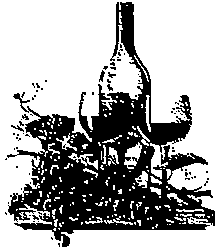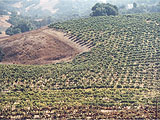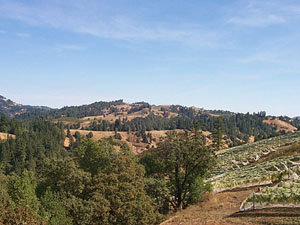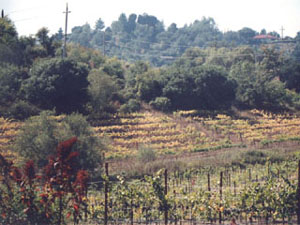Essential wines for the beginner
Bordeaux wines
Burgundy wines
Chianti wines
Rioja wines
Beaujolais wines
California Cabernet Sauvignon wines
-----------------------------------------------
For many wine lovers, Bordeaux wine is the most prestigious red wine in the world. Although dry and sweet white wines are also made in the Bordeaux region, 83% of Bordeaux wine is red. The Bordeaux region has a maritime, temperate climate. The wines from Bordeaux can cost as little as $6 per bottle or well over $100 a bottle. Invariably, as fine Bordeaux wine age, they increase in price. One of the reasons why Bordeaux wine has become so famous among wine lovers is that the best wines of the region are good and very expensive, taking on legendary status as they age. Some of the regions in Bordeaux are widely recognised for producing some of the best wines in the world. The Pauillac village for their Chateau Mouton-Rothschild and Chateau Latour, the Pomerol village for their Chateau Petrus and Chateau Trotanoy, and the Graves/Pessac-Leognan village for its Chateau Haut-Brion.
The winemakers in Bordeaux have narrowed down the red grape varieties to five. These grapes are ( in order of importance ) Cabernet Sauvignon, Merlot, Cabernet Franc, Petit Verdot and Malbec. All red Bordeaux wines are blends of wine from at least two of the grapes from the list. As the Bordeaux region is situated on the Atlantic Coast of France, it is subject to unpredictable weather. For example, a warm, sunny summer and a dry autumn would bring perfect ripeness and richer, fuller-bodied wines. However, the most common end products are medium-bodied wines.
What then does the typical Bordeaux wine taste like? The typical Bordeaux wine is dry, medium-bodied, firm and somewhat austere. It has a moderately intense aroma and flavour of black current, plum, herb, vegetation and cedar. Polished and refined and yet somewhat, reserved and ungiving, it harbors subtle complexities that can intrigue wine drinkers. In restaurants, it would be prudent to order an inexpensive Bordeaux. Although it might not be as prestigious than the more expensive wines, chances are that it would be less tannic than the finer wines and as a result, taste better.
No other place in the world has ever been able to match the red Burgundy, ie. Pinot Noir, or the fruity red wine otherwise known as Beaujolais, or the Chardonnay grape. Burgundy wine, from the Burgundy region of eastern France, is a product of a continental climate - rather hot summers and cold winters. The soils in the areas of Burgundy, mainly limestone and red clay soil, seem particularly suited for the Pinot Noir grape. Further south where the soil is granitic and sandy, the Gamay grape thrives ( home of the Beaujolais ). Although the top vineyard sites of Burgundy hold higher status than other vineyards of the region, these top vineyards do not all have the same status. Some are ranked as 'premier cru' while some are ranked higher, ie. 'grand cru'. However, it does not necessarily mean that grand cru Burgundies are always the best wines, while premier cru Burgundies pale in comparison. The truth is that the classification rank is the least important critertion to consider when buying a Burgundy. One should consider other factors like a producer's reputation ( a lower-ranking wine from a good producer is usually of a better quality than a higher-ranking wine from a less able producer ), the vintage and the appellation ( the region, district, village or vineyard name ).
The general style of Burgundy wine is that of being fairly full-bodied, ample and generous, with moderately high alcohol and moderately intense aromas and flavours of berries and earth. These excellent characteristics make Burgundy an excellent choice in restaurants. It is enjoyable young and goes well with fish and seafood. Even with these characteristics, it must be noted that Burgundy wines vary according to where the grapes grew and according to how much care the producer takes in growing the grapes and according to the producer's personal stylistic preferences.
Such producers are also known as negociant houses, large firms that buy grapes and/or wine from growers and blend the wines or grapes of many growers to produce their own Burgundy wines in their own house style. Some of the well-known negociant houses include Louis Jardot, Joseph Drouhlin, Louis Latour and Georges Duboeuf.
Chianti is Italy's most famous wine export. It comes from the Chianti district of central Italy. Chianti wines have labels that indicate which subzone the grapes come from. The least expensive Chianti wines are simply labeled Chianti, while the better wines indicate a specific subzone, such as Chianti Classico or Chianti Rufina, on their labels. Chianti is traditionally a blended wine, made primarily from the Sangiovese grape, along with the red grape called Canaiolo and small amounts of two local white grapes, Trebbiano and Malvasia. The best Chianti wines however, are made entirely from the noble Sangiovese grapes. The Chianti production zone, in central Tuscany, has the great city of Florence at its northern border and Florence's traditional rival, the city of Siena, at its southern end. A winery in Chianti is known as a castello or villa. Most producers make at least two different Chianti wines, ie. light Chianti wine to drink when it is young or a serious Chianti wine that is labeled with the word riserva.
The aromas and flavors of Chianti are subtle and fine. Since the Chianti wine is always dry, there isn't a slightest impression of sweetness or juiciness in it. A light-bodied to medium-bodied wine with low to moderate tannin, its nutty character makes it an apt choice to go with venison or mutton.
The pioneers of super-Tuscan wines include that of Antinori, Castello dei Rampolla and Incisa della Rocchetta. Apart from the high quality that is associated with the super-Tuscan wines, they are also generally more expensive and difficult to obtain as they are made in small quantities.
Rioja wines are the best-known and best-loved type of Spanish wines. It has become so popular that it has now found its way onto the retail shelves and restaurant wine lists all over the world. It comes from the Rioja wine region of northeastern Spain. The main grape used is the Tempranillo grape, often blended with Grenache, and less so, with Mazuelo and Graciano ( all native Spanish varieties ). The style of the wine varies with the type of grapes that go into the blend, and with the region the grapes are grown. For example, those wines with a higher percentage of Grenache, are usually higher in alcohol, less tannic and less fruity than wines with less Grenache.
The world sees three different types of Rioja. The Crianza wines are light bodied and ready-to-drink wines. They are aged for two years in oak cask and bottle at the winery. After this process, they no longer require any further aging. For Reserva wines, they represent a step up in quality. They are aged for three years in oak and bottle. These reserva wines, more applicable to the better vintages, can age for ten years or more for better end results. The Gran Reservas wines are the finest and most complex Riojas and are usually made in good vintages. Some Riojas that I would recommend include the "Vina Tondonia" reserva by R.Lopez de Heredia and the "Imperial" gran reserva by CVNE.
A medium-bodied, soft, and mellow type of wine with only moderate levels of tannin, the Rioja has a wonderful vanilla aroma and flavour tha comes from the barrels in which the wine ages. Depending on how long the wine is left to mature, it can have aged aromas like that of leather or decaying leaves or more youthful aromas like that of dried red fruits.
Although the Beaujolais is officially part of the Burgundy region, it is such a famous wine that it stands out on its own. Beaujolais uses an entirely different grape variety from other red Burgundies. Beaujolais wine is made solely from the Gamay grape. The finest Beaujolais wines come from ten vineyard areas surrounding specific villages in the northern part of the Beaujolais district. Grapes from these areas, where granite and schist soil bulids more intensity and concentration into the wine, become Beaujolais Village wines. These are medium-weight Beaujolais wines, with more character than basic Beaujolais. Most Beaujolais wines are sold by large negociants. Two of the largest and most reliable negociants that deal with Beaujolais are Louis Jardot and Georges Duboeuf.
The Beaujolais is a light to medium-bodied dry wine with crisp acidity and low to moderate tannins. Its aromas and flavours are pronounced and fruity. As it is relatively simple and insignificant, the Beaujolais is ideal for lunch dates or barbecues. Beaujolais wines are also relatively inexpensive, thus making them suitable for budget-tight parties.
A Beaujolais should be drunk slightly chilled ( about 13 deg cel ) to enjoy its lively, fruity exuberance. The more serious cru Beaujolais wines however, should be served at about the same temperature as other red Burgundies, ie. 17 deg cel.
California Cabernet Sauvignon wines
In the short modern history of California winemaking, the state has managed to make a type of wine that is stylistically unique - the California Cabernet Sauvignon. The usual blending partner in Cabernet Sauvignon wines is the Merlot grape. The best Cabernet Sauvignon grapes grow in areas that are not too warm, have high-altitude nights that enable the grapes to ripen fully but not so quickly that they would lose their fresh flavours. The most famous area where these grapes are grown is the Napa Valley. Cabernet Sauvignons will accompany all red meats, roasted or grilled. Even cheeses - from milky Bries to mature Cheddars and from strong Roqueforts to crumbly Parmesans - find a soul mate in Cabernet Sauvignons. The wines can also be enjoyed with fruit. Strawberries dipped in sour cream and sprinkled with cracked black pepper become an unusual yet delightful complement to the Sauvignon. Take a look at the list : Vineyard 29, Screaming Eagle, Grace Family, Bryant Family, Moraga. Many of these names would not be found in standard textbooks. However, they are all super-hot producers of Cabernets which sell for well over US$100 a bottle.
Most good California Cabernet wines have these common characteristics : deep, dark colored, intense aroma ( black currant fruit ), fresh flavours of ripe berry and plum fruit, high alcohol and tannins. Many of these wines are so richly fruity that they are delicious when they are young. The hallmark of the Cabernet Sauvignon has to be its irresistible, delicious fruitiness. The wine varies in style according to the region the grapes are grown. For example, the wines from the Stags Leap district have very soft tannins while the wines from the mountain vineyards are toughened by firm tannins.
The World's most costly wines ( price per bottle, $US ) before the year 2000
Regions/Countries Recent Vintage Very Rare Red Bordeaux Chateau Petrus(1982)= 1500 Chateau Mouton Rothschild(1945)= 4200 Red Burgundy Domaine de la Romanee Conti(1985)= 3300 - White Burgundy DRC Montrachet(1996)= 830 - Sauternes Chateau d'Yquem(1990)= 190 Chateau d'Yquem(1811)= 26500 Rhone Hermitage La Chapelle Jaboulet(1997)= 85 Hermitage La Chapelle Jaboulet(1961)= 1400 Champagne Dom Perignon Rose(1990)= 200 Moet & Chandon, Espirit de Siecle= 10000 California Opus One(1995)= 120 Screaming Eagle(1995)= 1000 Spain Vega Sicilia(1986)= 100 Vega Sicilia(1968)= 375 Australia Grange(1990)= 300 Grange(1955)= 1400 Italy Brunello di Montalcino Riserva(1990)= 250 -
Information in table courtesy of the Economist Publications:Vol 353, No. 8150
Links
Wine searcher
The Laws And Sciences Governing The Wine





